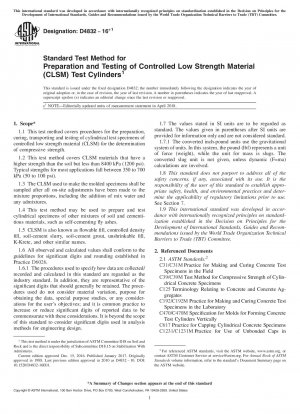ASTM D4832-16e1
Standard test method for preparation and testing of controlled low strength material (CLSM) test cylinders
- Standard No.
- ASTM D4832-16e1
- Release Date
- 2016
- Published By
- American Society for Testing and Materials (ASTM)
- Status
- Replace By
- ASTM D4832/D4832M-23
- Latest
- ASTM D4832/D4832M-23
- Scope
- 1.1 This test method covers procedures for the preparation, curing, transporting and testing of cylindrical test specimens of controlled low strength material (CLSM) for the determination of compressive strength. 1.2 This test method covers CLSM materials that have a higher strength than the soil but less than 8400 kPa (1200 psi). Typical strengths for most applications fall between 350 to 700 kPa (50 to 100 psi). 1.3 The CLSM used to make the molded specimens shall be sampled after all on-site adjustments have been made to the mixture proportions, including the addition of mix water and any admixtures. 1.4 This test method may be used to prepare and test cylindrical specimens of other mixtures of soil and cementitious materials, such as self-cementing fly ashes. 1.5 CLSM is also known as flowable fill, controlled density fill, soil-cement slurry, soil-cement grout, unshrinkable fill, K-Krete, and other similar names. 1.6 All observed and calculated values shall conform to the guidelines for significant digits and rounding established in Practice D6026. 1.6.1 The procedures used to specify how data are collected/ recorded and calculated in this standard are regarded as the industry standard. In addition, they are representative of the significant digits that should generally be retained. The procedures used do not consider material variation, purpose for obtaining the data, special purpose studies, or any considerations for the user’s objectives; and it is common practice to increase or reduce significant digits of reported data to be commensurate with these considerations. It is beyond the scope of this standard to consider significant digits used in analysis methods for engineering design. 1.7 The values stated in SI units are to be regarded as standard. The values given in parentheses after SI units are provided for information only and are not considered standard. 1.7.1 The converted inch-pound units use the gravitational system of units. In this system, the pound (lbf) represents a unit of force (weight), while the unit for mass is slugs. The converted slug unit is not given, unless dynamic (F=ma) calculations are involved. 1.8 This standard does not purport to address all of the safety concerns, if any, associated with its use. It is the responsibility of the user of this standard to establish appropriate safety, health, and environmental practices and determine the applicability of regulatory limitations prior to use. See Section 7. 1.9 This international standard was developed in accordance with internationally recognized principles on standardization established in the Decision on Principles for the Development of International Standards, Guides and Recommendations issued by the World Trade Organization Technical Barriers to Trade (TBT) Committee.
ASTM D4832-16e1 Referenced Document
- ASTM C1231/C1231M Standard Practice for Use of Unbonded Caps in Determination of Compressive Strength of Hardened Cylindrical Concrete Specimens
- ASTM C125 Standard Terminology Relating to Concrete and Concrete Aggregates
- ASTM C192/C192M Standard Practice for Making and Curing Concrete Test Specimens in the Laboratory
- ASTM C31/C31M Standard Practice for Making and Curing Concrete Test Specimens in the Field
- ASTM C39/C39M Standard Test Method for Compressive Strength of Cylindrical Concrete Specimens
- ASTM C470/C470M Standard Specification for Molds for Forming Concrete Test Cylinders Vertically
- ASTM C617 Standard Practice for Capping Cylindrical Concrete Specimens
- ASTM D3740 Standard Practice for Minimum Requirements for Agencies Engaged in the Testing and/or Inspection of Soil and Rock as Used in Engineering Design and Construction
- ASTM D5971 Standard Practice for Sampling Freshly Mixed Controlled Low-Strength Material
- ASTM D6023 Standard Test Method for Unit Weight, Yield, Cement Content, and Air Content (Gravimetric) of Controlled Low Strength Material (CLSM)
- ASTM D6024 Standard Test Method for Ball Drop on Controlled Low Strength Material (CLSM) to Determine Suitability for Load Application
- ASTM D6026 Standard Practice for Using Significant Digits in Geotechnical Data
- ASTM D6103 Standard Test Method for Flow Consistency of Controlled Low Strength Material (CLSM)
- ASTM D653 Standard Terminology Relating to Soil, Rock, and Contained Fluids
ASTM D4832-16e1 history
- 2023 ASTM D4832/D4832M-23 Standard Test Method for Preparation and Testing of Controlled Low Strength Material (CLSM) Cylindrical Test Specimens
- 2016 ASTM D4832-16e1 Standard test method for preparation and testing of controlled low strength material (CLSM) test cylinders
- 2016 ASTM D4832-16 Standard Test Method for Preparation and Testing of Controlled Low Strength Material (CLSM) Test Cylinders
- 2010 ASTM D4832-10 Standard Test Method for Preparation and Testing of Controlled Low Strength Material (CLSM) Test Cylinders
- 2002 ASTM D4832-02 Standard Test Method for Preparation and Testing of Controlled Low Strength Material (CLSM) Test Cylinders
- 1995 ASTM D4832-95e1 Standard Test Method for Preparation and Testing of Controlled Low Strength Material (CLSM) Test Cylinders
